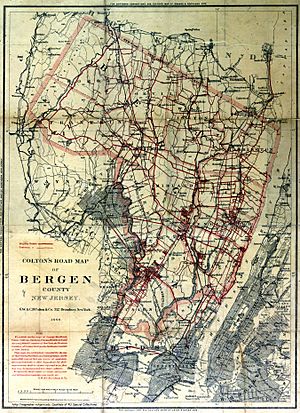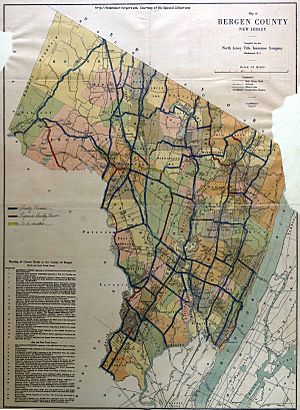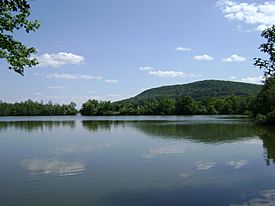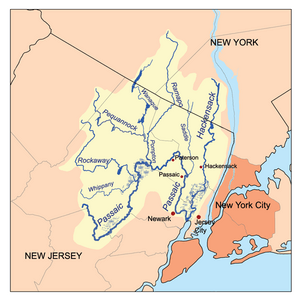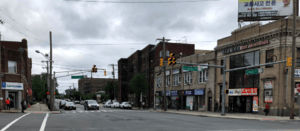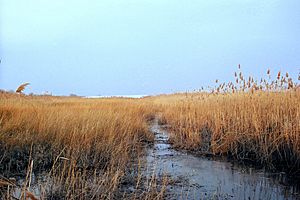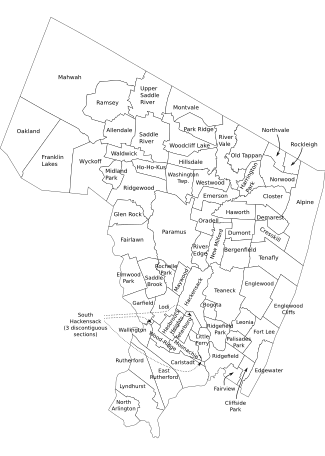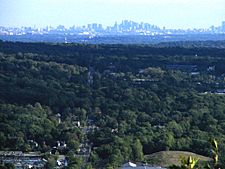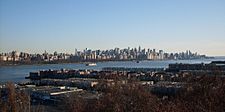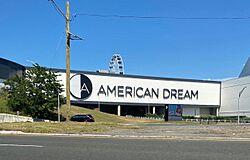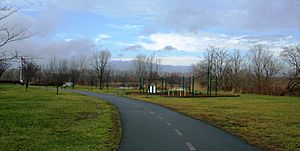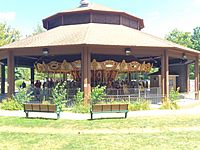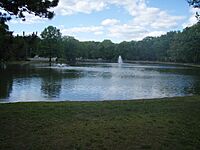Bergen County, New Jersey facts for kids
Quick facts for kids
Bergen County
|
|||
|---|---|---|---|
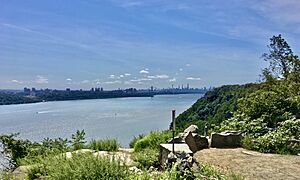
Atop the Hudson Palisades in Englewood Cliffs, overlooking the Hudson River, the George Washington Bridge, and the skyscrapers of Midtown Manhattan
|
|||
|
|||
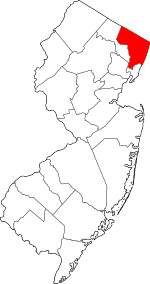
Location within the U.S. state of New Jersey
|
|||
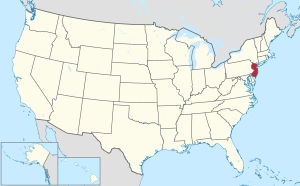 New Jersey's location within the U.S. |
|||
| Country | |||
| State | |||
| Founded | 1683 | ||
| Named for | Bergen, Norway or Bergen op Zoom, Netherlands | ||
| Seat | Hackensack | ||
| Largest municipality | Hackensack (population) Mahwah (area) |
||
| Area | |||
| • Total | 246.45 sq mi (638.3 km2) | ||
| • Land | 232.79 sq mi (602.9 km2) | ||
| • Water | 13.66 sq mi (35.4 km2) 5.5% | ||
| Population
(2020)
|
|||
| • Total | 955,732 | ||
| • Estimate
(2023)
|
957,736 |
||
| • Density | 3,878.00/sq mi (1,497.302/km2) | ||
| Demonym(s) | Bergenite | ||
| Time zone | UTC−5 (Eastern) | ||
| • Summer (DST) | UTC−4 (EDT) | ||
| Congressional districts | 5th, 9th | ||
| Range in altitude: Highest elevation: 1,152 ft (351 m) (Bald Mountain, in the Ramapo Mountains, in Mahwah). Lowest elevation: 0 ft (0 m) (sea level), at the Hudson River in Edgewater. |
|||
Bergen County is the county in New Jersey with the most people. It's located in the northeastern part of the state. Bergen County and its many towns are a very developed part of the New York City metropolitan area. It borders the Hudson River. The famous George Washington Bridge connects Bergen County with Manhattan. This county is part of the North Jersey region.
In 2020, about 955,732 people lived here. This was the highest number ever counted for the county. It showed an increase of over 50,000 people since 2010.
Bergen County has 70 different towns, which is more than any other county in New Jersey. These towns include 56 boroughs, nine townships, three cities, and two villages. The town with the most residents is Hackensack, which is also the county seat. Mahwah is the largest town by land area.
Bergen County is a major business area in New Jersey and the United States. Stores in Paramus alone make over $6 billion in sales each year. This is impressive because of "blue laws" that keep most stores closed on Sundays. Bergen County is also one of the wealthiest counties in the U.S. The average household income is much higher than the state or national average. Homes here are also quite expensive. The county's park system covers more than 9,000 acres.
Contents
- What Does the Name "Bergen" Mean?
- A Look Back: Bergen County's History
- Bergen County's Geography
- Who Lives in Bergen County?
- Getting Around: Transportation
- Learning in Bergen County: Education
- Fun Things to Do: Arts and Culture
- Towns and Cities: Municipalities
- Bergen County's Economy
- Fun Outdoors: Parks and Recreation
- See Also
What Does the Name "Bergen" Mean?
The exact meaning of the name "Bergen County" is still debated. Many people believe it comes from one of the first settlements called Bergen. This old settlement is now part of Hudson County, New Jersey.
However, the name of that township is also a mystery. Some say it's named after Bergen, Norway. Others think it comes from Bergen op Zoom in the Netherlands. A few sources suggest it's named after Hans Hansen Bergen. He was an early settler from Norway who came to New Amsterdam (now New York City) in 1633.
A Look Back: Bergen County's History
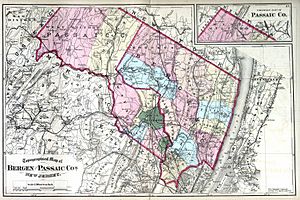
When Europeans first arrived, Native American groups lived in Bergen County. These included the Lenape Nation, with groups like the Tappan and Hackensack. Some of their descendants are now part of the Ramapough Mountain Indians. They are recognized as a tribe by the state. Their ancestors moved into the mountains to avoid the Dutch and English settlers.
In the 1600s, the Dutch claimed this area as part of New Netherland. This was their colony in the Dutch Republic. The Dutch brought enslaved Africans to work here. By 1800, nearly 20% of Bergen County's population was enslaved. These individuals worked in ports, as servants, in trades, and on farms.
Early Dutch settlements faced challenges from Native Americans. Conflicts like Kieft's War (1643–1645) and the Peach War (1655) pushed settlers back. But by the 1660s, Bergen Township became a lasting European settlement.
In 1664, the English took over New Amsterdam. They created the Province of New Jersey. In 1683, Bergen was officially recognized as an independent county.
Originally, Bergen County was smaller. It only included land between the Hudson River and the Hackensack River. In 1709, its borders grew to include all of today's Hudson County and parts of Passaic County.
Bergen County was important during the American Revolutionary War. Fort Lee was a key location because it was across from Fort Washington in Manhattan. In November 1776, the Battle of Fort Lee happened. American forces had to retreat quickly, leaving supplies behind. This retreat allowed them to escape and later win important battles.
In 1837, Passaic County was created from parts of Bergen and Essex counties. In 1840, Hudson County was also formed from Bergen. These changes reduced Bergen County's size and population.
In 1894, a new state law made it easy to form small towns called boroughs. This led to "boroughitis." Many new towns were created in just a few years. Bergen County ended up with 56 boroughs, the most in New Jersey.
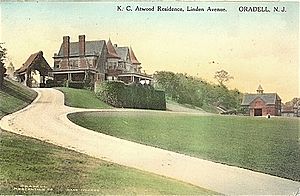
In 1917, the Kingsland Explosion happened at a factory in Lyndhurst. It's believed to have been an act of sabotage. Later that year, Camp Merritt was built in eastern Bergen County. It housed 50,000 soldiers at a time before they went to Europe for World War I.
The George Washington Bridge was finished in 1931. It connected Fort Lee to Manhattan. This bridge helped Bergen County grow rapidly after World War II. It became a busy suburban area. The bridge was expanded over the years. Today, it is the world's busiest bridge for cars, carrying 104 million vehicles in 2019.
Bergen County's Geography

Bergen County is in the northeastern corner of New Jersey. It borders Rockland County, New York, to the north. To the east, it's across the Hudson River from Manhattan, the Bronx, and Westchester County, New York. Within New Jersey, it borders Hudson County and Passaic County.
The county covers about 246 square miles. Most of this is land, with about 13 square miles of water.
The highest point in Bergen County is Bald Mountain in Mahwah, which is 1,164 feet above sea level. The lowest point is at sea level along the Hudson River.
The New Jersey Palisades are sharp cliffs that rise from the Hudson River on the eastern side of the county. The middle part of the county is flatter, with the Hackensack River valley and the Pascack Valley. In the northwest, the county becomes hilly again, sharing the Ramapo Mountains with New York.
Dams on the Hackensack River and Pascack Brook created three large water storage areas: Woodcliff Lake Reservoir, Lake Tappan, and Oradell Reservoir. These provide drinking water to many residents in Bergen and Hudson counties. The Hackensack River flows through the New Jersey Meadowlands, a wetlands area in the south. The Saddle River and Ramapo River also drain parts of the county.
Bergen County's Climate
| Weather chart for Hackensack, New Jersey | |||||||||||||||||||||||||||||||||||||||||||||||
|---|---|---|---|---|---|---|---|---|---|---|---|---|---|---|---|---|---|---|---|---|---|---|---|---|---|---|---|---|---|---|---|---|---|---|---|---|---|---|---|---|---|---|---|---|---|---|---|
| J | F | M | A | M | J | J | A | S | O | N | D | ||||||||||||||||||||||||||||||||||||
|
3.7
38
19
|
3.2
41
22
|
4.4
50
30
|
4.5
62
40
|
4.2
72
50
|
4.4
81
60
|
4.6
86
65
|
4.4
84
63
|
4.3
76
55
|
4.4
64
42
|
4
54
34
|
4
43
25
|
||||||||||||||||||||||||||||||||||||
| temperatures in °F precipitation totals in inches source: The Weather Channel |
|||||||||||||||||||||||||||||||||||||||||||||||
|
Metric conversion
|
|||||||||||||||||||||||||||||||||||||||||||||||
Southeastern Bergen County has a humid subtropical climate. This means its winters are milder than areas further inland in New Jersey. Bergen County gets a good amount of sunshine each year.
In Hackensack, average temperatures range from 19°F in January to 86°F in July. The record low was -15°F in February 1934, and the record high was 106°F in July 1936. The county gets about 3 to 4.6 inches of rain each month.
Who Lives in Bergen County?
| Historical population | |||
|---|---|---|---|
| Census | Pop. | %± | |
| 1790 | 12,601 | — | |
| 1800 | 15,156 | 20.3% | |
| 1810 | 16,603 | 9.5% | |
| 1820 | 18,178 | 9.5% | |
| 1830 | 22,412 | 23.3% | |
| 1840 | 13,223 | * | −41.0% |
| 1850 | 14,725 | 11.4% | |
| 1860 | 21,618 | 46.8% | |
| 1870 | 30,122 | 39.3% | |
| 1880 | 36,786 | 22.1% | |
| 1890 | 47,226 | 28.4% | |
| 1900 | 78,441 | 66.1% | |
| 1910 | 138,002 | 75.9% | |
| 1920 | 210,703 | 52.7% | |
| 1930 | 364,977 | 73.2% | |
| 1940 | 409,646 | 12.2% | |
| 1950 | 539,139 | 31.6% | |
| 1960 | 780,255 | 44.7% | |
| 1970 | 897,148 | 15.0% | |
| 1980 | 845,385 | −5.8% | |
| 1990 | 825,380 | −2.4% | |
| 2000 | 884,118 | 7.1% | |
| 2010 | 905,116 | 2.4% | |
| 2020 | 955,732 | 5.6% | |
| 2023 (est.) | 957,736 | 5.8% | |
| Historical sources: 1790–1990 1970–2010 2020 * = Territorial change in previous decade |
|||
2020 Census Information
In 2020, Bergen County had 955,732 people. There were 343,733 households. The population density was about 3,900 people per square mile.
The racial makeup was:
- 56.90% White
- 5.73% African American
- 0.47% Native American
- 16.59% Asian
- 10.17% from two or more races
- 21.41% were Hispanic or Latino (of any race)
About 21.3% of the population was under 18 years old. The median age was 42.1 years. The median household income was $108,827. About 5.6% of the population lived below the poverty line.
A Diverse Community
Bergen County is very diverse, with people from many different backgrounds. This is partly because it's so close to Manhattan. The most common countries of birth for people living here who were born outside the U.S. are South Korea, Poland, and India.
Italian Americans
Italian Americans have a long history in Bergen County. In 2013, about 168,974 residents said they had Italian heritage. Many towns in the southern part of the county, like South Hackensack and Lyndhurst, have a large number of Italian American residents.
Latin Americans
The Hispanic and Latin American population in Bergen County is growing. Many live in towns like Fairview, Hackensack, and Englewood. Traditionally, many were from Colombia and Cuba. Now, more people are coming from Peru, Mexico, Guatemala, and other Latin American countries.
Western European Americans
Irish Americans and German Americans are also large groups in Bergen County. In 2013, about 115,914 residents were of Irish heritage, and 80,288 were of German heritage. Towns like Waldwick and Ho-Ho-Kus have high percentages of Irish American residents.
Jewish Americans
Bergen County has the largest Jewish population in New Jersey. Many towns, including Fair Lawn, Teaneck, and Tenafly, have many Jewish residents. There are many synagogues and kosher food stores in these areas.
Korean Americans
South Koreans are the largest group of foreign-born residents in Bergen County. In 2010, all of the top ten U.S. towns with the highest percentage of Korean residents were in Bergen County. Palisades Park has a majority (53.7%) of Korean residents.
The Korean American community is growing fast, especially near the George Washington Bridge. In 2022, 6.5% of Bergen County's population was of Korean ancestry. This is the highest percentage for any county in the United States. Many Korean companies, like Samsung and LG, have offices here. Since 2012, election ballots in Bergen County are printed in Korean.
Polish Americans
Polish Americans are also a large and growing community in Bergen County. In 2013, about 59,294 residents were of Polish descent. The town of Wallington has the largest concentration of Polish residents in New Jersey, with 45.5% of its population being of Polish descent.
African Americans
Most of the county's African American community lives in three towns: Englewood, Teaneck, and Hackensack. These three areas have nearly 70% of the county's total African American population. African Americans have lived in these towns since the county's early days.
Indian Americans
Indian Americans are a rapidly growing group in Bergen County. In 2013, there were over 40,000 Indian Americans here. Large groups live in Hackensack, Ridgewood, and Fair Lawn. Bergen County has America's largest Malayali community. There are also Sikh and Hindu places of worship in the county.
Russian and Other Former Soviet Americans
Fair Lawn, Tenafly, and Fort Lee are home to many Russian Americans, including Russian Jews. Other groups from former Soviet countries, like Ukrainian Americans, have also moved to Bergen County.
Filipino Americans
Bergenfield, along with Paramus and Hackensack, are growing centers for Filipino Americans. In 2013, about 20,859 Filipino Americans lived in Bergen County. Bergenfield is sometimes called Little Manila because of its many Filipino residents and businesses.
Chinese Americans
The Chinese American population is spread out in Bergen County. Large groups live in Fort Lee, Paramus, and Ridgewood. Many schools in the county now teach Mandarin Chinese.
Japanese Americans
The Japanese community has a long presence in Fort Lee and Edgewater. These two towns have the largest concentration of Japanese Americans in New Jersey. Edgewater has the largest Japanese-focused shopping center on the U.S. East Coast.
Balkan Americans
Greek Americans have lived in Bergen County for many decades. In 2000, there were over 13,000 Greek residents. You can find many Greek restaurants here. More recently, Macedonian Americans and Albanian Americans have also settled in towns like Garfield and Elmwood Park.
Iranian Americans
A newer community of Iranian Americans has grown in Bergen County. Many work in professional jobs across the county.
Muslim Community
Bergen County has a moderate-sized Muslim population. Teaneck and Hackensack have become important Muslim communities. The Muslim population includes Arab Americans, South Asian Americans, and African Americans.
Getting Around: Transportation
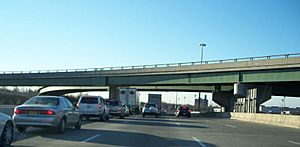
As of 2010, Bergen County had nearly 3,000 miles of roads. These include major highways like the New Jersey Turnpike (part of Interstate 95), the Garden State Parkway, and Interstate 80.
Other important roads include:
- U.S. Routes: 1/9, 9W, 46, 202
- State Highways: 3, 4, 5, 7, 17, 63, 67, 93, 120, 208
- Other: Palisades Interstate Parkway
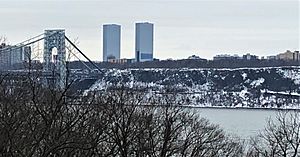
Bridges and Tunnels The George Washington Bridge connects Fort Lee in Bergen County to New York City. It is the busiest bridge in the world for cars. You can also reach New York City through the Lincoln Tunnel and Holland Tunnel in Hudson County.
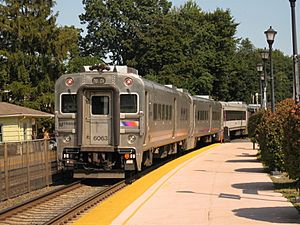
Public Transportation Train service is available on three lines from NJ Transit: the Bergen County Line, the Main Line, and the Pascack Valley Line. These trains go to Hoboken Terminal, where you can connect to other trains like the PATH. Buses also offer local and express service within Bergen County, to other parts of New Jersey, and to New York City.
Airports Bergen County has one airport, Teterboro Airport in Teterboro. The three busiest commercial airports in the New York City area (JFK, Newark Liberty, and LaGuardia) are all within 25 miles of Bergen County.
Learning in Bergen County: Education
Colleges and Universities

Bergen County is home to several colleges and universities:
- Bergen Community College in Paramus
- Eastwick College in Ramsey and Hackensack
- Fairleigh Dickinson University in Teaneck and Hackensack
- Felician University in Lodi and Rutherford
- Ramapo College in Mahwah
School Districts
The county has many public school districts. Some districts serve students from kindergarten to 12th grade. Others are regional high school districts or elementary school districts.
Some of the high schools in Bergen County are highly ranked. For example, Northern Highlands Regional High School and Pascack Hills High School are often listed among the best in New Jersey. The Bergen County Academies in Hackensack is a public magnet high school. It is known as one of the best high schools in the United States.
There is also a school for Japanese students in Oakland.
Fun Things to Do: Arts and Culture
The Bergen Performing Arts Center (PAC) is in Englewood. There are also many museums throughout the county. ArtsBergen is a group that helps connect artists and art organizations in Bergen County.
Educational and Cultural Spots
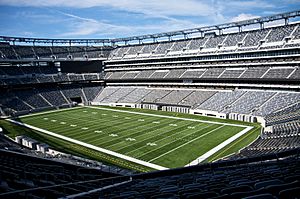

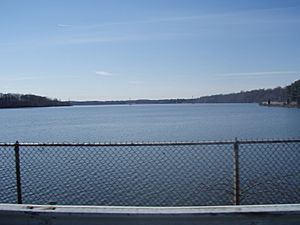
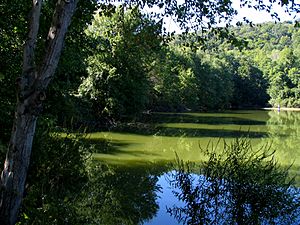
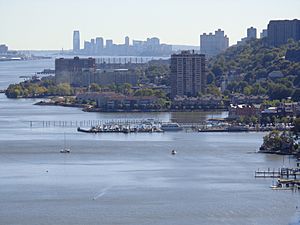
- New Jersey Naval Museum in Hackensack: You can tour the USS Ling submarine here.
- Aviation Hall of Fame and Museum of New Jersey in Teterboro: Learn about airplanes and space.
- Bergen Museum of Art & Science in Hackensack.
- Buehler Challenger & Science Center in Paramus: A fun place for science.
- Meadowlands Environment Center in Lyndhurst.
- Tenafly Nature Center in Tenafly.
- Maywood Station Museum in Maywood.
- Bergen Performing Arts Center in Englewood.
Shopping and Entertainment
- MetLife Stadium in East Rutherford: Home to the New York Giants and New York Jets football teams. It was one of the most expensive stadiums ever built.
- Meadowlands Racetrack in East Rutherford.
- Garden State Plaza in Paramus: One of the largest shopping malls in the U.S.
- The Shops at Riverside in Hackensack.
- Paramus Park in Paramus.
- The Outlets at Bergen Town Center in Paramus.
- Fashion Center in Paramus.
- H Mart in Ridgefield: An Asian shopping center.
- Mitsuwa Marketplace in Edgewater: A Japanese shopping center.
- American Dream Meadowlands in East Rutherford: A huge shopping and entertainment complex that opened in 2019. It has over 200 stores.
Towns and Cities: Municipalities
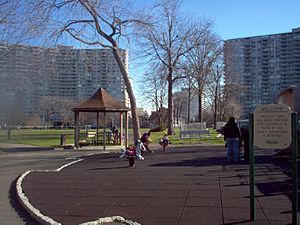
In the late 1800s, Bergen County started dividing its larger townships into many smaller boroughs. This was because of state laws that allowed boroughs to have lower taxes. This led to a period called "boroughitis." Many new towns were created quickly.
Today, Bergen County has 70 municipalities, which is the most in New Jersey. Fifty-six of these are boroughs.
Here is a list of the 70 towns in Bergen County:
| Municipality (with map key) |
Municipal type |
Population | Housing Units |
Total Area |
Water Area |
Land Area |
Pop. Density |
Housing Density |
School District | Communities |
|---|---|---|---|---|---|---|---|---|---|---|
| Allendale | borough | 6,848 | 2,388 | 3.12 | 0.02 | 3.10 | 2,100.7 | 771.2 | Northern Highlands (9-12) Allendale (PK-8) |
|
| Alpine | borough | 1,762 | 670 | 9.23 | 2.82 | 6.41 | 288.4 | 104.5 | Tenafly (9-12) Alpine (K-8) |
|
| Bergenfield | borough | 28,321 | 9,200 | 2.89 | 0.01 | 2.88 | 9,306.5 | 3,199.1 | Bergenfield | |
| Bogota | borough | 8,778 | 2,888 | 0.81 | 0.05 | 0.76 | 10,702.5 | 3,775.4 | Bogota | |
| Carlstadt | borough | 6,372 | 2,495 | 4.24 | 0.24 | 4.00 | 1,532.1 | 623.9 | Carlstadt-East Rutherford (9-12) Carlstadt (PK-8) |
|
| Cliffside Park | borough | 25,693 | 10,665 | 0.96 | 0.00 | 0.96 | 24,508.7 | 11,078.5 | Cliffside Park | Grantwood (part) |
| Closter | borough | 8,594 | 2,860 | 3.30 | 0.13 | 3.16 | 2,646.0 | 903.8 | Northern Valley (9-12) Closter (PK-8) |
|
| Cresskill | borough | 9,155 | 3,114 | 2.07 | 0.01 | 2.06 | 4,154.5 | 1,509.0 | Cresskill | |
| Demarest | borough | 4,981 | 1,659 | 2.08 | 0.01 | 2.07 | 2,361.8 | 802.7 | Northern Valley (9-12) Demarest (PK-8) |
|
| Dumont | borough | 17,863 | 6,542 | 1.99 | 0.00 | 1.98 | 8,814.7 | 3,299.2 | Dumont | |
| East Rutherford | borough | 10,022 | 4,018 | 4.05 | 0.34 | 3.71 | 2,403.2 | 1,083.4 | Carlstadt-East Rutherford (9-12) East Rutherford (PK-8) |
|
| Edgewater | borough | 14,336 | 6,282 | 2.42 | 1.49 | 0.94 | 12,312.0 | 6,718.0 | Leonia (7-12) (S/R) Edgewater (PK-6) |
|
| Elmwood Park | borough | 21,422 | 7,385 | 2.76 | 0.11 | 2.65 | 7,327.9 | 2,789.1 | Elmwood Park | |
| Emerson | borough | 7,290 | 2,552 | 2.40 | 0.20 | 2.20 | 3,358.9 | 1,158.2 | Emerson | |
| Englewood | city | 29,308 | 10,695 | 4.94 | 0.02 | 4.91 | 5,524.6 | 2,176.5 | Englewood | |
| Englewood Cliffs | borough | 5,342 | 1,924 | 3.33 | 1.24 | 2.09 | 2,528.1 | 921.0 | Englewood (9-12) (S/R) Englewood Cliffs (PK-8) |
|
| Fair Lawn | borough | 34,927 | 12,266 | 5.20 | 0.06 | 5.14 | 6,315.4 | 2,386.7 | Fair Lawn | Radburn |
| Fairview | borough | 15,025 | 5,150 | 0.84 | 0.00 | 0.84 | 16,421.8 | 6,112.9 | Cliffside Park (9-12) (S/R) Fairview (PK-8) |
|
| Fort Lee | borough | 40,191 | 17,818 | 2.89 | 0.35 | 2.54 | 13,910.9 | 7,012.7 | Fort Lee | |
| Franklin Lakes | borough | 11,079 | 3,692 | 9.85 | 0.47 | 9.38 | 1,129.1 | 393.6 | Ramapo Indian Hills (9-12) Franklin Lakes (PK-8) |
|
| Garfield | city | 32,655 | 11,788 | 2.16 | 0.06 | 2.10 | 14,524.8 | 5,616.1 | Garfield | |
| Glen Rock | borough | 12,133 | 4,016 | 2.74 | 0.02 | 2.71 | 4,275.2 | 1,480.0 | Glen Rock | |
| Hackensack | city | 46,030 | 19,375 | 4.35 | 0.17 | 4.18 | 10,290.0 | 4,635.4 | Hackensack | |
| Harrington Park | borough | 4,741 | 1,624 | 2.06 | 0.23 | 1.83 | 2,545.9 | 886.5 | Northern Valley (9-12) Harrington Park (PK-8) |
|
| Hasbrouck Heights | borough | 12,125 | 4,627 | 1.51 | 0.00 | 1.51 | 7,865.4 | 3,073.2 | Hasbrouck Heights | |
| Haworth | borough | 3,343 | 1,136 | 2.36 | 0.41 | 1.94 | 1,739.2 | 584.2 | Northern Valley (9-12) Haworth (PK-8) |
|
| Hillsdale | borough | 10,143 | 3,567 | 2.96 | 0.01 | 2.95 | 3,464.8 | 1,209.4 | Pascack Valley (9-12) Hillsdale (PK-8) |
|
| Ho-Ho-Kus | borough | 4,258 | 1,462 | 1.75 | 0.01 | 1.74 | 2,350.3 | 842.6 | Northern Highlands (9-12) Ho-Ho-Kus (PK-8) |
|
| Leonia | borough | 9,304 | 3,428 | 1.63 | 0.10 | 1.54 | 5,819.5 | 2,232.2 | Leonia | |
| Little Ferry | borough | 10,987 | 4,439 | 1.70 | 0.23 | 1.48 | 7,200.1 | 3,007.8 | Ridgefield Park (9-12) (S/R) Little Ferry (PK-8) |
|
| Lodi | borough | 26,206 | 10,127 | 2.29 | 0.02 | 2.26 | 10,657.6 | 4,471.7 | Lodi | |
| Lyndhurst | township | 22,519 | 8,787 | 4.89 | 0.34 | 4.56 | 4,509.3 | 1,927.7 | Lyndhurst | Kingsland |
| Mahwah | township | 25,487 | 9,868 | 26.19 | 0.50 | 25.69 | 1,007.7 | 384.1 | Mahwah Township | Cragmere Park Darlington Fardale Masonicus Pulis Mills Ramapo College of New Jersey CDP (2,200) |
| Maywood | borough | 10,080 | 3,769 | 1.29 | 0.00 | 1.29 | 7,428.0 | 2,930.0 | Hackensack (9-12) (S/R) Maywood (PK-8) |
|
| Midland Park | borough | 7,014 | 2,861 | 1.56 | 0.01 | 1.56 | 4,583.2 | 1,839.6 | Midland Park | Wortendyke |
| Montvale | borough | 8,436 | 2,872 | 4.01 | 0.01 | 4.00 | 1,961.2 | 718.1 | Pascack Valley (9-12) Montvale (PK-8) |
|
| Moonachie | borough | 3,133 | 1,053 | 1.68 | 0.01 | 1.66 | 1,626.5 | 632.5 | Wood-Ridge (9-12) (S/R)
Moonachie (PK-8) |
|
| New Milford | borough | 16,923 | 6,362 | 2.31 | 0.03 | 2.27 | 7,186.0 | 2,797.7 | New Milford | |
| North Arlington | borough | 16,457 | 6,573 | 2.62 | 0.06 | 2.56 | 6,010.3 | 2,566.6 | North Arlington | |
| Northvale | borough | 4,761 | 1,635 | 1.30 | 0.00 | 1.30 | 3,582.3 | 1,262.3 | Northern Valley (9-12) Northvale (PK-8) |
|
| Norwood | borough | 5,641 | 2,007 | 2.73 | 0.01 | 2.73 | 2,093.5 | 735.7 | Northern Valley (9-12) Norwood (PK-8) |
|
| Oakland | borough | 12,748 | 4,470 | 8.73 | 0.27 | 8.45 | 1,508.6 | 528.7 | Ramapo Indian Hills (9-12) Oakland (K-8) |
|
| Old Tappan | borough | 5,888 | 1,995 | 4.20 | 0.87 | 3.33 | 1,725.8 | 598.8 | Northern Valley (9-12) Old Tappan (K-8) |
|
| Oradell | borough | 8,244 | 2,831 | 2.58 | 0.15 | 2.42 | 3,291.5 | 1,168.0 | River Dell (7-12) Oradell (K-6) |
|
| Palisades Park | borough | 20,292 | 7,362 | 1.28 | 0.02 | 1.25 | 15,681.6 | 5,883.6 | Palisades Park | |
| Paramus | borough | 26,698 | 8,915 | 10.52 | 0.05 | 10.47 | 2,516.0 | 851.5 | Paramus | Arcola |
| Park Ridge | borough | 8,883 | 3,428 | 2.60 | 0.02 | 2.58 | 3,348.6 | 1,327.8 | Park Ridge | |
| Ramsey | borough | 14,798 | 5,550 | 5.59 | 0.07 | 5.52 | 2,621.9 | 1,005.4 | Ramsey | |
| Ridgefield | borough | 11,501 | 4,145 | 2.85 | 0.30 | 2.55 | 4,323.7 | 1,624.5 | Ridgefield | Grantwood (part) |
| Ridgefield Park | village | 13,224 | 5,164 | 1.92 | 0.20 | 1.72 | 7,385.6 | 2,996.2 | Ridgefield Park | |
| Ridgewood | village | 25,979 | 8,743 | 5.82 | 0.07 | 5.75 | 4,339.0 | 1,520.0 | Ridgewood | |
| River Edge | borough | 12,049 | 4,261 | 1.90 | 0.04 | 1.85 | 6,116.3 | 2,298.2 | River Dell (7-12) River Edge Elementary (PK-6) |
|
| River Vale | township | 9,909 | 3,521 | 4.28 | 0.26 | 4.01 | 2,408.1 | 877.8 | Pascack Valley (9-12) River Vale (PK-8) |
|
| Rochelle Park | township | 5,814 | 2,170 | 1.06 | 0.02 | 1.04 | 5,313.8 | 2,085.2 | Hackensack (9-12) (S/R) Rochelle Park (PK-8) |
|
| Rockleigh | borough | 407 | 86 | 0.98 | 0.01 | 0.97 | 548.1 | 88.8 | Northern Valley (9-12) (S/R) Northvale (K-8) (S/R) |
|
| Rutherford | borough | 18,834 | 7,278 | 2.94 | 0.14 | 2.81 | 6,437.4 | 2,594.1 | Rutherford | |
| Saddle Brook | township | 14,294 | 5,485 | 2.72 | 0.03 | 2.69 | 5,080.2 | 2,040.0 | Saddle Brook | |
| Saddle River | borough | 3,372 | 1,341 | 4.98 | 0.06 | 4.92 | 640.2 | 272.4 | Northern Highlands (9-12) (S/R) Ramsey (6-12) (S/R) Saddle River (PK-5) |
|
| South Hackensack | township | 2,701 | 879 | 0.74 | 0.02 | 0.72 | 3,311.7 | 1,224.1 | Hackensack (9-12) (S/R) South Hackensack (PK-8) |
|
| Teaneck | township | 41,246 | 14,024 | 6.23 | 0.22 | 6.01 | 6,622.2 | 2,334.8 | Teaneck | |
| Tenafly | borough | 15,409 | 4,980 | 5.18 | 0.58 | 4.60 | 3,148.6 | 1,082.3 | Tenafly | |
| Teterboro | borough | 61 | 27 | 1.16 | 0.00 | 1.16 | 57.9 | 23.3 | Hasbrouck Heights | |
| Upper Saddle River | borough | 8,353 | 2,776 | 5.28 | 0.02 | 5.26 | 1,560.0 | 527.6 | Northern Highlands (9-12) Upper Saddle River (PK-8) |
|
| Waldwick | borough | 10,058 | 3,537 | 2.09 | 0.02 | 2.07 | 4,656.8 | 1,711.3 | Waldwick | |
| Wallington | borough | 11,868 | 4,946 | 1.03 | 0.05 | 0.98 | 11,528.6 | 5,030.5 | Wallington | |
| Washington Township | township | 9,285 | 3,341 | 2.96 | 0.05 | 2.91 | 3,128.8 | 1,148.5 | Westwood Regional | |
| Westwood | borough | 11,282 | 4,636 | 2.31 | 0.05 | 2.27 | 4,814.5 | 2,046.2 | Westwood Regional | |
| Woodcliff Lake | borough | 6,128 | 1,980 | 3.61 | 0.20 | 3.41 | 1,682.7 | 581.5 | Pascack Valley (9-12) Woodcliff Lake (PK-8) |
|
| Wood-Ridge | borough | 10,137 | 3,051 | 1.10 | 0.00 | 1.10 | 6,951.6 | 2,781.2 | Wood-Ridge | |
| Wyckoff | township | 16,585 | 5,827 | 6.61 | 0.06 | 6.55 | 2,550.1 | 890.0 | Ramapo Indian Hills (9-12) Wyckoff (PK-8) |
|
| Bergen County | county | 955,732 | 352,388 | 246.67 | 13.66 | 233.01 | 3,884.5 | 1,512.3 |
Bergen County's Economy
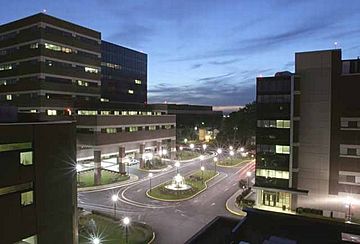
In 2022, Bergen County's economy produced $81.5 billion in goods and services. This was the highest in New Jersey.
Major Employers
Here are some of the largest employers in Bergen County as of 2012:
- Hackensack University Medical Center, Hackensack (8,000 employees)
- Valley Health System, Ridgewood (4,660 employees)
- Bio-Reference Laboratories, Inc., Elmwood Park (2,900 employees)
- County of Bergen, Hackensack (2,390 employees)
- Quest Diagnostics, Teterboro/Lyndhurst (2,200 employees)
- KPMG, Montvale (2,100 employees)
- Englewood Hospital and Medical Center, Englewood (2,002 employees)
- Unilever Bestfoods, Englewood Cliffs (1,900 employees)
- Stryker Corporation, Allendale/Mahwah (1,812 employees)
- Holy Name Medical Center, Teaneck (1,695 employees)
- Becton Dickinson, Franklin Lakes (1,500 employees)
- Crestron Electronics, Rockleigh/Cresskill (1,500 employees)
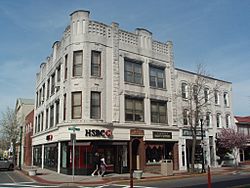
In 2015, Mercedes-Benz USA moved its main office from Montvale to Georgia. However, they kept their Northeast regional office and a training center in Montvale.
Retail Industry
The retail industry is a very important part of Bergen County's economy. It brings in a lot of money, especially in Paramus.
Garden State Plaza
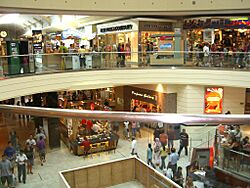
The Garden State Plaza is a huge mall in Paramus. It opened in 1957 as New Jersey's first suburban shopping mall. It has over 300 stores and is one of the highest-earning malls in the United States.
American Dream Meadowlands
American Dream is another large shopping and entertainment complex. It is located in East Rutherford. It opened in stages starting in 2019. It now has over 200 stores and other businesses.
Blue Laws
Bergen County has "blue laws" that keep most stores closed on Sundays. These laws apply to clothing, shoes, furniture, electronics, and home appliances. Grocery stores, gas stations, restaurants, and pharmacies can stay open.
Most other counties in New Jersey have voted to get rid of these laws. But in Bergen County, many residents like the blue laws. They want one day a week with less traffic and more peace. This is especially true in Paramus, where many large malls are located. Even with these laws, Paramus is the top retail ZIP Code in the U.S., making over $6 billion in sales each year.
In 2012, Governor Chris Christie temporarily stopped the blue law after Hurricane Sandy. But it was put back in place a week later.
Minimum Wage
In 2017, the Bergen County Executive raised the minimum wage for full-time county workers. It will gradually increase to $15 per hour over six years. This was the first time a New Jersey county raised its minimum wage.
Fun Outdoors: Parks and Recreation
State Parks
- Ramapo Mountain State Forest in Mahwah
- Palisades Interstate Park in Fort Lee, Englewood Cliffs, Tenafly, and Alpine
State Historical Sites
- New Bridge Landing in River Edge, Teaneck, and New Milford
- The Hermitage in Ho-Ho-Kus
- Steuben House in River Edge
County Parks
- Bergen Equestrian Center in Leonia
- Belmont Hill County Park in Garfield
- Campgaw Mountain Reservation in Mahwah: Offers skiing, snowboarding, and hiking.
- Dahnert's Lake County Park in Garfield
- Darlington County Park in Mahwah
- McFaul Environmental Center in Wyckoff
- Ramapo Valley County Reservation in Mahwah
- Overpeck County Park in Leonia, Palisades Park, and Ridgefield Park
- Riverside County Park in Lyndhurst and North Arlington
- Pascack Brook County Park in Westwood
- Saddle Ridge Riding Area in Franklin Lakes
- Saddle River County Park in Paramus, Glen Rock, Rochelle Park, Saddle Brook, and Ridgewood
- Samuel Nelkin County Park in Wallington
- Van Saun County Park in Paramus: Includes the Bergen County Zoological Park, the county's only zoo.
- Wood Dale County Park in Woodcliff Lake
County Historical Sites
- Baylor Massacre site in River Vale: Where a surprise attack happened during the American Revolutionary War.
- Camp Merritt in Cresskill.
- Campbell-Christie House in River Edge: An old Dutch stone home.
- Easton Tower in Paramus.
- Garretson Farm in Fair Lawn: A stone home from the 1720s, one of the oldest buildings in the county.
- Gethsemane Cemetery in Little Ferry.
- Washington Spring Garden in Van Saun Park, Paramus.
- Wortendyke Barn in Park Ridge.
See Also
 In Spanish: Condado de Bergen para niños
In Spanish: Condado de Bergen para niños




